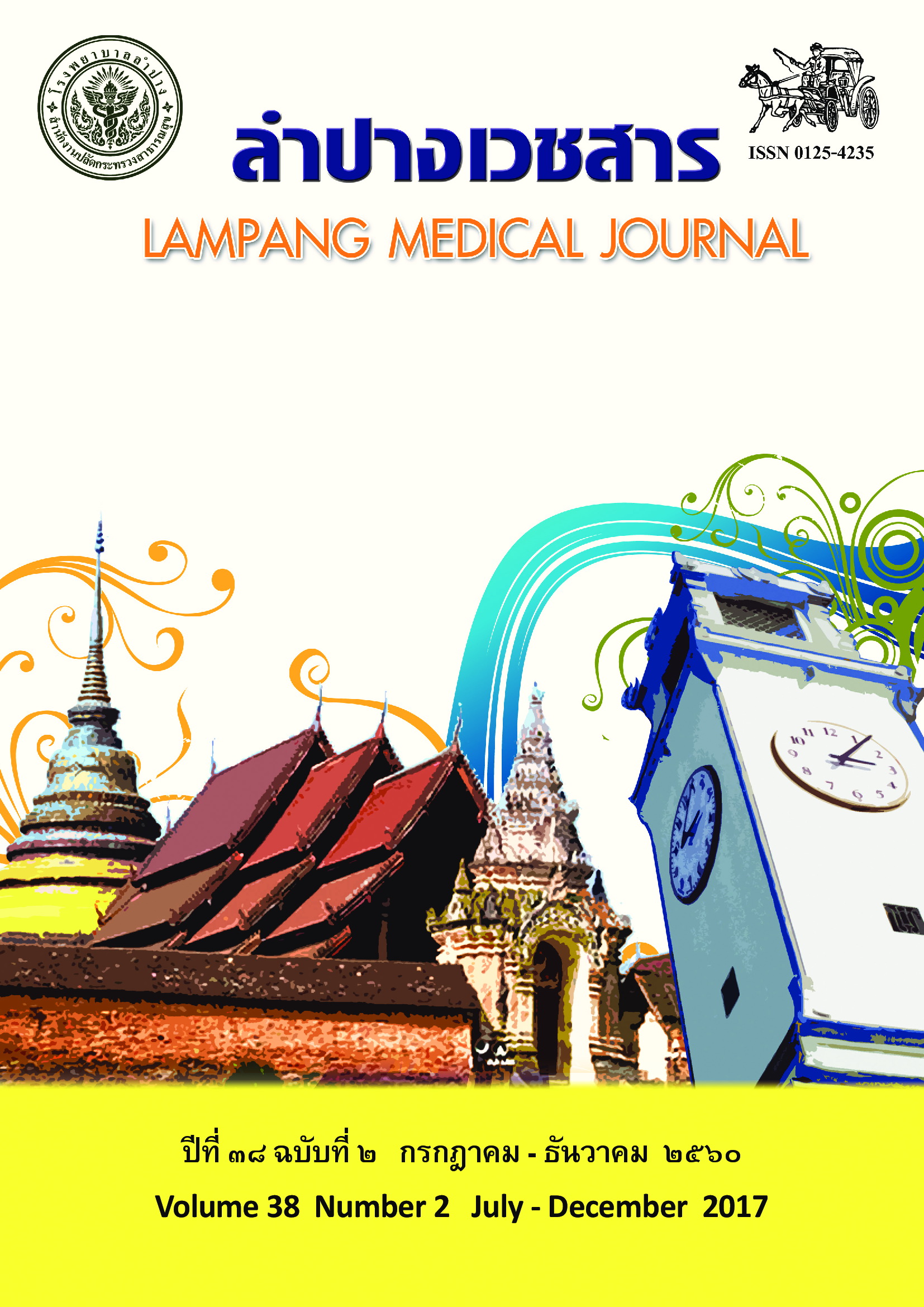Prevalence of Depressive Mood and Related Factors among HIV/AIDS Patients at Somdej Phrayanasangworn Hospital, Chiang Rai
Main Article Content
Abstract
Background: Depressive mood is one of the public health problems. Information about depressive mood among HIV/AIDS patients is limited.
Objective: To estimate the prevalence of and factors related to depressive mood among HIV/ AIDS patients at Somdej Phrayanasangworn Hospital.
Materials and method: A cross-sectional study was conducted among 250 adult HIV/AIDS patients attending the HIV clinic of this hospital from May to August 2016. The research questionnaire consisted of 5 parts: socio-demographic data, the WHO Quality of Life Assessment in Thai (WHOQOL-BREF-THAI), social support factors, the Personal Health Questionnaire 9 (PHQ-9) and suicidal ideation (8Q). The data were analyzed by using descriptive statistics,
Chi-square test, Fisher’s exact test and multiple logistic regression.
Results: The mean age was 44.5 ± 8.4 years (range, 19-80). Fifty-four percent were female. The prevalence of depressive mood was 9.6%. The significant factors related to depressive mood among HIV/AIDS patients were poor mental health quality (OR=8.12; 95% CI=1.46-45.18), inadequate income (OR=5.97; 95% CI=1.27-27.16), family history of depression (OR=4.06; 95% CI=1.14-14.44) and age <40 year (OR=3.37; 95% CI=1.23-9.26)
Conclusion: The prevalence of depressive mood among HIV/AIDS patients was 9.6% in this hospital. Poor mental health quality, inadequate income, family history of depression and age <40 year were significant related factors. The necessity to integrate mental health interventions into routine clinical care and appropriate mental support should be emphasized.
Article Details
บทความที่ส่งมาลงพิมพ์ต้องไม่เคยพิมพ์หรือกำลังได้รับการพิจารณาตีพิมพ์ในวารสารอื่น เนื้อหาในบทความต้องเป็นผลงานของผู้นิพนธ์เอง ไม่ได้ลอกเลียนหรือตัดทอนจากบทความอื่น โดยไม่ได้รับอนุญาตหรือไม่ได้อ้างอิงอย่างเหมาะสม การแก้ไขหรือให้ข้อมูลเพิ่มเติมแก่กองบรรณาธิการ จะต้องเสร็จสิ้นเป็นที่เรียบร้อยก่อนจะได้รับพิจารณาตีพิมพ์ และบทความที่ตีพิมพ์แล้วเป็นสมบัติ ของลำปางเวชสาร
References
2. ศันสนีย์ สมิตะเกษตริน. การศึกษาสุขภาพจิตของผู้ติดเชื้อ ผู้ป่วยเอดส์ที่เข้าชมรมผู้ติดเชื้อ. นนทบุรี: กองโรคเอดส์ กรมควบคุมโรค กระทรวงสาธารณสุข; 2542.
3. สมภพ เรืองตระกูล. ตำราจิตเวชสำหรับแพทย์เวชปฏิบัติทั่วไป : อาการทางจิตเวชในผู้ป่วยโรคทางกาย. กรุงเทพมหานคร: เรือนแก้วการพิมพ์; 2543.
4. สุวัฒน์ มหัตนิรันดร์กุล และคณะ. เปรียบเทียบแบบวัดคุณภาพชีวิตขององค์การอนามัยโลกทุก 100 ตัวชี้วัดและ 26 ตัวชี้วัด. เชียงใหม่: โรงพยาบาลสวนปรุง กรมสุขภาพจิต กระทรวงสาธารณสุข; 2540.
5. รัตนกุล โพธิ. ปัจจัยที่มีความสัมพันธ์กับสัมพันธภาพของสมาชิกที่อยู่ร่วมกันในครอบครัวผู้ติดเชื้อเอดส์:ศึกษาเฉพาะกรณี โครงการบ้านนิจจานุเคราะห์ [วิทยานิพนธ์พยาบาลศาสตรมหาบัณฑิต]. ขอนแก่น: มหาวิทยาลัยขอนแก่น; 2543.
6. Lotrakul M, Sumrithe S, Saipanish R. Reliability and validity of the Thai version of the PHQ-9. BMC Psychiatry 2008;8:46.
7. กรมสุขภาพจิต กระทรวงสาธารณสุข. แนวทางการดูแลเฝ้าระวังโรคซึมเศร้า ระดับจังหวัด (ฉบับปรับปรุง ครั้งที่ 1). กรุงเทพมหานคร: โรงพิมพ์ชุมนุมสหกรณ์การเกษตรแห่งประเทศไทย; 2552.
8. Lemeshow S, Hosmer DW, Klar J, Lwanga SK. Adequacy of sample size in health studies. England: John Wiley & Sons; 1990.
9. เกษรา อุ่นใจ. ผลของการดูแลรักษาโรคซึมเศร้าในผู้ป่วยเอดส์/ผู้ติดเชื้อเอชไอวีต่อความร่วมมือในการรับประทานยาต้านไวรัสเอดส์. ใน: ศันสนีย์ สมิตะเกษตริน, จิรวัฒน์ อุปริรัตน์, บรรณาธิการ. การสัมมนาระดับชาติเรื่องโรคเอดส์ ครั้งที่ 13. นนทบุรี: ส?ำนักโรคเอดส์ วัณโรคและโรคติดต่อทางเพศสัมพันธ์ กรมควบคุมโรค กระทรวงสาธารณสุข; 2554. หน้า 156.
10. ไชยยันต์ ตั๋นปาลี. Prevalence of depression among HIV/AIDS patients in Chiang Mai Province [วิทยานิพนธ์วิทยาศาสตรมหาบัณฑิต]. กรุงเทพมหานคร: มหาวิทยาลัยมหิดล; 2556.
11. ทฏะวัฎร์ พิลึกภควัต. รายงานเบื้องต้น: ความชุกของภาวะซึมเศร้าและปัจจัยที่เกี่ยวข้องในผู้ป่วยเด็กและวัยรุ่นที่ติดเชื้อเอชไอวี.วารสารสุขภาพจิตแห่งประเทศไทย 2557;22:186-94.
12. Jiang Y, Wang M, Wei XQ, He JM, Guo TS, Huang GQ, et al. Prevalence of depression and related factors in 180 HIV/AIDS patients receiving highly active antiretroviral therapy. Zhonghua Liu Xing Bing Xue Za Zhi 2016;37:638-42.
13. Bing EG, Burnam MA, Longshore D, Fleishman JA, Sherbourne CD, London AS, et al. Psychiatric disorders and drug use among human immunodeficiency virus-infected adults in the United States. Arch Gen Psychiatry 2001;58:721-8.
14. Bhatia MS, Munjal S. Prevalence of depression in people living with HIV/AIDS undergoing ART and factors associated with it. J Clin Diagn Res 2014;8:WC01-4.
15. ธรรมนาถ เจริญบุญ. แบบประเมินและแบบคัดกรองภาวะซึมเศร้าในประเทศไทย: ข้อควรพิจารณาในการเลือกใช้. ธรรมศาสตร์เวชสาร 2554;11:667-76.
16. เปรมจิตร์ ตันบุญยืน, ยุวดี ลีลัคนาวีระ, พรนภา หอมสินธุ์. ปัจจัยท?ำนายคุณภาพชีวิตของผู้ติดเชื้อเอชไอวีและผู้ป่วยเอดส์. วารสารพยาบาลสาธารณสุข 2558;29:80-97.
17. Palmer AK, Duncan KC, Ayalew B, Zhang W, Tzemis D, Lima V, et al. “The way I see it”: the effect of stigma and depression on self-perceived body image among HIV-positive individuals on treatment in British Columbia, Canada. AIDS Care 2011;23:1456-66.
18. พรชัย เรือนสิทธิ์. พฤติกรรมส่งเสริมสุขภาพจิตของผู้ติดเชื่อเอชไอวี [วิทยานิพนธ์พยาบาลศาสตร มหาบัณฑิต]. เชียงใหม่: มหาวิทยาลัยเชียงใหม่; 2545.
19. Vornanen M, Konttinen H, Kaariainen H, Mannisto S, Salomaa V, Perola M, et al. Family history and perceived risk of diabetes, cardiovascular disease, cancer, and depression. Prev Med 2016;90:177-83.
20. Arboleda-Florez J, Wade TJ. Childhood and adult victimization as risk factor for major depression. Int J Law Psychiatry 2001;24:357-70.


